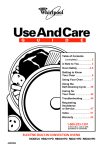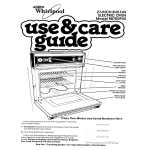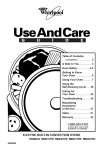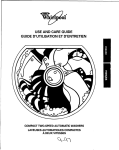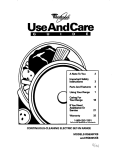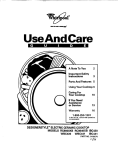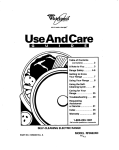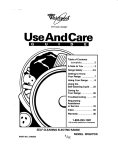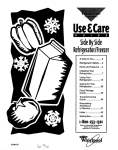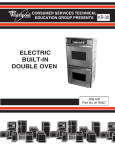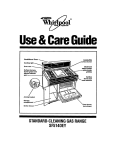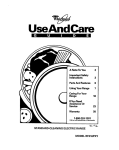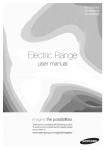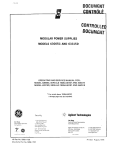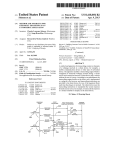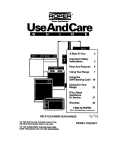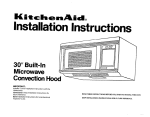Download Whirlpool RBD277PD User's Manual
Transcript
TKitil 4a 01 UseAndCare Table of Contents (complete) .. . . . . . . . . . . . . . . . . . 2 A Note to You ... ...... .... .... 3 Oven Safety .. ............ ...... 4 Getting to Know Your Oven ........ ..... ...... ... 6 Using Your Oven ........... 7 Using the Self-Cleaning Cycle ..... 33 Caring for Your Oven ........ ...... .... .. 41 Troubleshooting .......... 43 Requesting Assistance or Service ..................... 45 Index ............................. 47 Warranty ....................... 46 1-800-253-1301 In the U.S.A., call us with questions or comments. ELECTRIC BUILT-IN THERMAL-CONVECTION MODELS PART NO. 4449366 RBS277PD RBS307PD OVENS RBD277PD RBD307PD 5195 Table of Contents A Note to You ............................................ Oven Safety .............................................. Getting to Know Your Oven ..................... Using Your Oven ...................................... 3 4 6 7 Positioning racks and pans .................. 7 For best air circulation .......................... 7 Using aluminum foil for baking ............. 8 The electronic oven control .................. 8 Starting a function Canceling a function ................................ 9 10 Setting the clock ................................ 10 Using the electronic Minute Timer ...... 10 Audible signals .................................. 12 2 .......................... Oven settings ..................................... 13 Baking/roasting 13 .................................. Convection baking tips ....................... 16 Adjusting the oven temperature control ............................ 16 Broiling 18 .............................................. Broiling tips ........................................ 20 Energy saving tips ............................. 20 Using the electronic MEALTIMER* control ............................................... 20 The oven vent(s) ................................ 32 Using the Self-Cleaning Cycle ............... 33 Before you start ................................. 33 Before setting the controls .................. 34 Setting the controls ............................ 34 Special tips ........................................ 40 How the cycle works .......................... 40 Caring for Your Oven ............................. 41 Cleaning chart ................................... 41 The oven lights .................................. 42 Troubleshooting ..................................... 43 Requesting Assistance or Service ....... .45 Index ....................................................... 47 Warranty ................................................. 48 A Note to You Thank you for buying a WHIRLPOOL* appliance. Because your life is getting busier and more complicated, WHIRLPOOL ovens are easy to use, save time, and help you manage your home better. To ensure that you enjoy years of trouble-free operation, we developed this Use and Care Guide. It is full of valuable information about how to operate and maintain your appliance properly and safely. Please read it carefully. Also, please complete and mail the Ownership Product Registration Card (U.S.A. or Canadian, whichever applies to you) provided with your appliance. This will help us notify you about any new information on your appliance. Please record your model’s information. Whenever you call to request service for your appliance, you need to know your complete model number and serial number. You can find this information on the model and serial number plate (see diagram on page 6 for location of plate). Please also record the purchase date of your appliance and your dealer’s name, address, and telephone number. Keep this book and the sales slip together Model Number Serial Number Purchase Date Dealer Name Dealer Address Dealer Phone Our Consumer Assistance Center number is toll-free 24 hours a day (for U.S.A. only). in a safe place for future I-800-253-1 reference. 301 3 Oven Safety Your safety is important to us. This guide contains safety statements under warning symbols. Please pay special attention to these symbols and follow any instructions given. Here is a brief explanation of the use of the symbol. IMPORTANT SAFETY General @Read all instructions before using the oven. .Install or locate the oven only in accordance with the provided Installation Instructions. The oven must be installed by a qualified installer. The oven must be properly connected to electrical supply and grounded. GAUTION: Do not store things children might want above the oven. Children could be burned or injured while climbing on it. *Do not leave children alone or unattended in area where the oven is in use. They should never be allowed to sit or stand on any part of the oven. They could be burned or injured. ADO not operate the oven if it is damaged or not working properly. *Do not use the oven for warming or heating the room. Persons could be burned or injured, or a fire could start. aUse the oven only for its intended use as described in this manual. 4 I This symbol alerts you to such dangers as fire, electrical shock, burns, and oersonal iniurv. INSTRUCTIONS @Do not touch heating elements or interior surfaces of oven. Heating elements may be hot even though they are dark in color. Interior surfaces of an oven become hot enough to cause burns. During and after use, do not touch, or let clothing or other flammable materials contact heating elements or interior surfaces of oven until they have had sufficient time to cool. Other surfaces of the oven, such as the oven vent opening, the surface near the vent opening, and the oven door and window, could also become hot enough to cause burns. @Do not wear loose or hanging garments when using the oven. They could ignite if they touch a hot heating element and you could be burned. @Use only dry pot holders. Moist or damp pot holders on hot surfaces could result in burns from steam. Do not let pot holder touch hot heating elements. Do not use a towel or bulky cloth for a pot holder. It could catch on fire. @Keep oven vents unobstructed. ADO not heat unopened containers. They could explode. The hot contents could cause burns and container particles could cause injury. @Use only utensils approved for oven use. Follow utensil manufacturer’s instructions, especially when using glass or plastic utensils. @Do not store flammable materials on or near the oven. The fumes could create an explosion and/or fire hazard. @Do not repair or replace any part of the oven unless specifically recommended in this manual. All other servicing should be referred to a qualified technician. @Disconnect the electrical supply before servicing the oven. When l Always using the oven position oven rack(s) in desired location while oven is cool. If a rack must be removed while oven is hot, do not let pot holder contact hot heating element in oven. 4Jse care when opening oven door. Let hot air or steam escape before removing or replacing food. @Small amounts of formaldehyde and carbon monoxide are given off in the Self-Cleaning cycle from fiberglass insulation and food decomposition. Significant exposure to these substances can cause cancer or reproductive harm. Exposure can be minimized by venting with a hood or open window and wiping out excess food spills prior to selfcleaning. *Do not use oven cleaners. No commercial oven cleaner or oven liner protective coating of any kind should be used in or around any part of the oven. aBefore self-cleaning the oven, remove broiler pan, broiler grid, oven racks, and other utensils. Do not use your oven to clean miscellaneous parts unless you are instructed to do so in this Use and Care Guide. .Do not clean door seal. It is essential for a good seal. Care should be taken not to rub, damage, or move the seal. Clean only parts recommended in this Use and Care Guide. - SAVE THESE INSTRUCTIONS - 5 Getting to Know Your Oven This section tells you what features your oven has and where they are located. Please review this information before using your oven. To help you find information on specific parts or features quickly, page references are included. Feature (Models locations RBD277PD and RBD307PD shown) Electronic RlzKEElrn’B Oven lock latch II_.! Convection fan (shown without fan cover) (on rear wall) (p. 13) III I Ill1 Ilk Oven light (on left wall - not shown) (P. 42) \I oven control (P. 8) I Automatic oven light switch (P. 42) Broil element (P. 13) 1 Oven light (P. 42) Bake element (P. 13) serial number plate (on side of door) 6 Using Your Oven To obtain the best cooking results possible, you must operate your oven properly. This section gives you important information for efficient and safe use of your oven. Positioning For baking/roasting racks and pans with one rack, place the rack so the top of the food will be centered in the oven. NOTE: For recommended rack placement when broiling, see “Broiling rack position chart” on page 19. Rack placement for specific foods: FOOD RACK POSITION Frozen pies, large roasts, turkeys, angel food cakes Lowest level or 2nd level from bottom Bundt cakes, most quick breads, yeast breads, casseroles, meats 2nd level from bottom Cookies, biscuits, muff ins, cakes, nonfrozen pies 2nd or 3rd level from bottom When baking on two racks, arrange racks Personal Injury Hazard @Always position oven rack(s) in desired location before turning oven on. Be sure the rack(s) is level. l If rack(s) must be moved while oven is hot, use pot holders or oven mitts to protect hands. l Do not let pot holder or oven mitt touch heating elements. Failure to follow the above precautions could result in personal injury. on second and fourth level from bottom. To change rack posltion, lift rack at front and pull out. For best air circulation Use the following as a guide to determine where to place the pans: One pan Place in the center of the oven rack. Two pans Place in opposite corners of the oven rack. Three or four pans Hot air must circulate around the par;b in the oven for even heat to reach all parts of the oven. This results in better baking. l Place the pans so that one is not directly over the other. l For best results, allow 11/2to 2 inches (4-5 cm) of space around each pan and between pans and oven walls. There must be a minimum space of 1 inch (3 cm). l Use only one cookie sheet in the oven at a time. Place in opposite corners on each oven rack. Stagger pans so no pan is directly over another. 7 Using aluminum foil for baking Fire Hazard Do not allow foil to touch the heating elements. Failure to follow this precaution could result in fire or electrical shock hazard and damage to the elements. Use aluminum foil to catch spillovers from pies or casseroles: l Place the foil on the oven rack below the rack with the food. Turn up foil edges and make sure foil is about 1 inch (3 cm) larger all around than the dish holding the food. The electronic (Models RBD277PD l l Do not cover the entire rack with aluminum foil. It will reduce air circulation and cause poor cooking results. Do not line oven bottom or entire oven rack with foil or other liners. Poor baking will result. oven control and RBD307PD shown) NOTE: Displays shown are from single/upper ovens. Command pads shown are from double ovens. In some cases, lower oven displays and single oven command pads may look different than those shown. Electronic ovens only) (P. 9) setting pads Temperature pads Clock pad Timer set Electronic MEALTIMER* control pads (P. 20) pads pads enter pad (P. 9) cancel pads (P. 10) Display/clock l When you first plug in the oven, everything on the display will light up for a few seconds, then a time of day and “PF” will appear on the temperature display. If after you set the clock (page lo), “PF” again appears on the display, your electricity was off for a while. Reset the clock. 8 . When you are not uslng the oven, the control is an accurate clock. l When you are uslng the oven or Minute Timer, the display will show times, temperature settings, and what command pads have been pressed. l l When showing the time of day, the display will show the hour and minutes. Selecting When you are using the Minute Timer, To choose the oven you want to use, press the display will show hours, minutes, and seconds in the following sequence: - For settings from 1-59 minutes, the display will count down each second (minutes and seconds displayed). - For settings 1 hour or over, the display will count down each minute (hours and minutes displayed). l When you are using Cook Time and/or Stop Time, the display COOK TIME STOP TIME will show cooking time counting down. CID - For settings from 1-59 minutes, the display will count down each second (minutes and seconds displayed). - For settings 1 hour or over, the display will count down each minute (hours and minutes displayed). Command pads The command pads tell the oven what to do and in what order. Some command pads have an Indicator Light. The Indicator Light comes on when you press the command pad. The ON Indicator Light comes on when you press the Start/Enter pad for an oven function. Starting (double Using an oven ovens) the control lock The control lock prevents unwanted use of the oven by disabling most of the control panel command pads (except CLOCK, TIMER SET/OFF, and LIGHT). NOTES: Control lock is only available when oven l is not in use or control has not been set. l Set control lock when cleaning the control panel to prevent oven from accidentally turning on. To lock or deactivate the control panel: Press and hold the Start/Enter pad for 5 seconds. A single tone will sound and “Lot” and fi will appear on the temperature display. When the control is locked, ‘START?” will appear on the display if you press any command pad. To unlock the control panel: nd hold the Start/Enter pad for 5 seconds. A single tone will sound and “Lot” and fi will disappear from the temperature display. a function After programming a function, you must press the Start/Enter pad to start the function. If you do not press the Start/Enter pad within 5 seconds of programming, “START?” will show on the display as a reminder. 9 Canceling The Off/Cancel a function padwill .. . m OR ’ . ’ . . ml lllll (single ovens) ldouble ovens) being used, the time Setting cancel any function except for the Clock and Timer Set functions. When you press the Off/Cancel pad, the display will show the time of day or if Minute Timer is also remaining. NOTE: You may hear a fan blowing in the oven even after you press the Off/Cancel pad. This is the cooling fan. It will turn off when the oven cools to a certain temperature. the clock NOTE: Displays shown are from single/upper ovens. Command pads shown are from double ovens. In some cases, lower oven displays and single oven command pads may look different than those shown. 1. Press Clock pad. PRESS YOU SEE (last time of day set) 2. Set time. PRESS YOU SEE (example 3. Start clock. PRESS NOTE: If you do not want the clock time displayed, press and hold the Clock pad for 5 seconds. To display the clock time again, press and hold the Clock pad for 5 seconds. You should not have to reset the time. Using the electronic The Minute Timer does not start or stop the oven. It works like a kitchen timer. It can be set in hours and minutes up to 12 hours 59 minutes. The Minute Timer will display minutes and seconds for settings under one hour. You will hear four 1-second tones when the set time is up. 10 for 5:30) YOU SEE ’ Minute Timer NOTE: Displays shown are from single/ upper ovens. Command pads shown are from double ovens. In some cases, lower oven displays and single oven command pads may look different than those shown. 1, Press Timer Set pad. 2. Set time. PRESS YOU SEE Press the “up” (A) or “down” (V) pad(s) until the correct time shows on the display. (example 3. Start Minute Timer. PRESS for ten minutes) YOU SEE The Minute Timer will begin counting down immediately after the timer is started. miiiii (display counts YOU SEE When the time is up: You will hear four 1-second tones, then four 1-second reminder tones every minute until you press the Timer Off pad. NOTE: To disable the reminder tones, press and hold the Timer Set pad for 5 seconds. To reactivate the tones, follow the same step. After disabling or reactivating reminder tones, a single tone will sound and the display will return to the Minute Timer countdown or the time of day. 4. Turn off Minute Timer. PRESS YOU SEE (time of day) To cancel the Minute Timer: PRESS YOU SEE Press Timer Off pad. (time of day) down) - Audible signals Audible signals tell you if a function is entered correctly or not. They also tell you when a cycle is completed. To shut off all signals except for error tones and the hidden function signal: Press and hold the Stop Time pad for 5 seconds. A short tone will sound to tell you the signals have been changed. “Snd” and “On” or “Snd” ST:: and “Off” will appear on the 0 display. Repeat the above step to turn the signals back on. 12 To choose between high and low volume signals: Press and hold the Delay Start Time pad for 5 seconds. A short tone will sound to tell you the signals have been changed. Either “HI” and it%i “Snd” or “LO” and “Snd” will 0 appear on the time display to show the volume you chose. If the volume is changed while the audible signals are off, when signals are turned back on they will be at the volume setting chosen. Oven settings This chart tells you when to use each setting. It also explains what elements heat up for each setting. SElTING DIAGRAM SElTlNG INFORMATION BAKE l Use this setting for baking and heating casseroles. l The bottom element and top element heat up. During baking, the elements will turn on and off to maintain the oven temperature. BROIL l The top element heats during Broil. Use this setting for broiling regular-sized and smaller cuts of meat, poultry, and fish. CONVECTION BAKE Use this setting for foods which require gentle heating and for baking breads and cakes. Use also when baking large quantities of food on more than one oven rack. CLEAN Use this setting for selfcleaning only. l l l l The bottom element and top element heat up. During convection baking, the elements will turn on and off to maintain the oven temperature. For even heating, the fan at the back of the oven circulates air in the oven cavity. The bottom element and top element heat up. Baking/roasting NOTE: Displays shown are from single/ upper ovens. Command pads shown are from double ovens. In some cases, lower oven displays and single oven command pads may look different than those shown. continued on next page 13 1. Position racks. For more information, see “Positioning racks and pans” on page 7. NOTE: When roasting, use the roasting rack that comes with your oven. Place it on the broiler pan (that also comes with your oven). (The roasting rack rests on the broiler pan, not inside it.) The long side of the rack should be parallel with the oven door for best heat distribution and airflow. 2. Choose baking/roasting setting. PRESS YOU SEE :1 M OR PRESS (for convection baking on single/upper oven only) 3. Set temperature (optional). Do this step if you want to set a temperature other than 350°F for bake or 325°F for convection bake. Press A to raise the temperature or V to lower the temperature in 5°F amounts. Use these pads until the desired temperature shows on the small display. (If the Temp pads are held down the temperature will change faster.) 4. When roasting or cooking casseroles, put food in oven. You do not have to preheat the oven when roasting or cooking casseroles. 14 PRESS YOU SEE 5. Press the Start/Enter pad. YOU SEE A preheat time will count down on the display. The oven control automatically sets preheat times depending on the oven temperature you select: Single ovens: TEMPERATURE PREHEAT TIME [in “F) b-325 1 325-375 375-500 tin min. and sec.) 5:45 7:30 11 :oo (example from double ovens for bake temperature of 350°F) I I Double ovens: 11 O-250 255-300 305-350 355-400 405-450 1 455-500 27” 3:30 4:45 6:30 8:30 10:30 12:30 30” 3:30 5:oo 6:30 8:30 10:30 13:oo The oven is preheated when you hear a 1-second tone and “PrE” on the display changes to the set temperature. NOTES: You can change the temperature l l setting any time after pressing the Start/Enter pad. However, you must press the Start/Enter pad again for the control to accept the temperature changes. The display will show “door” and the heating elements will not heat if the door is open when you try to bake/roast. (display shows set temperature after preheat) 6. When baking, put food in oven after oven is preheated. During baking/roasting, the elements will turn on and off to keep the oven temperature at the setting. NOTE: The top element helps heat during baking/roasting, but does not turn red. 15 7. After cooking, turn off oven. PRESS YOU SEE (single ovens) (time of day) OR (double Convection (convection l l l baking tips pad) Do not use aluminum foil when convection baking. Aluminum foil may block airflow. Reduce recommended recipe oven temperature by approximately 25°F. See recipe adaption chart in the convection oven cookbook for recommended temperatures. For most recipes, you can reduce convection baking time compared to standard baking times. See recipe adaption chart or convection baking chart in the convection oven cookbook for recommended baking times. Adjusting l NOTE: Cooking time may be longer when you use more than one rack. When baking on two racks, use the Convection setting for more even results. (You can, however, use only one rack when convection baking.) the oven temperature Although your new oven is properly adjusted to provide accurate temperatures, it may cook faster or slower than your old oven. If, after using the oven for a period of time, you are not satisfied with the baking/roasting results, you can change the offset temperature by following these steps: 16 ovens) control NOTE: DO NOT measure oven temperature with a thermometer. Opening the oven door will lower the oven temperature and give you an inaccurate reading. Also, the thermometer temperature reading will change as your oven cycles. NOTE: Displays shown are from single/ upper ovens. Command pads shown are from double ovens. In some cases, lower oven displays and single oven command pads may look different than those shown. 1. Press and hold Bake pad for PRESS YOU SEE (factory 2. Set new offset temperature. PRESS Press A to raise the temperature or V to lower the temperature in 10°F amounts. You can set the temperature change to as low as -30°F or as high as +3O”F. A minus (-) sign will appear before the number when decreasing the temperature setting to show the oven will be cooler by the displayed amount. There is no sign in front of the number when increasing the temperature setting. u setting of “0”) YOU SEE ’ (example vu 10°F hotter 3. Enter the adjustment. PRESS YOU SEE (time of day) How to determine the amount of adjustment The chart at the right tells you how much to adjust the offset temperature to get the desired cooking results. You can determine cooking results by the amount of browning, moistness, and rising times for baked foods. To display temperatures needed TO MAKE FOOD... r A little more done Moderately more done Much more done A little less done Moderately less done Much less done in “C instead ADJUST BY THIS NUMBER OF DEGREES + 1O”F/+6”C +2O”F/+12”C +3O”F/+16% - 1O”F/-6°C - 2O”F/-12°C - 3O”F/-16°C of OF: Press and hold the Custom Broil pad for 5 seconds. A short tone will sound and the temperatures displayed will be converted. To switch back to “F, repeat the instructions above. NOTE: The temperature display will go off after a conversion. The temperature display will reappear the next time you press a cook function command pad. 17 Broiling NOTE: Displays shown are from single/upper ovens. Command pads shown are from double ovens. In some cases, lower oven displays and single oven command pads may look different than those shown. NOTE: Preheating is not necessary when broiling. 1. Position rack. See “Broiling rack position chart” on page 19. 2. Put food on broiler pan and place in center of oven rack. 3. Close door. NOTE: Do not keep the door open as on other electric ovens. Unlike other electric ovens, the broil element will only stay on with the door closed. This gives you the high heat you need for broiling. However, if you leave the door open, the broil element will go off. 4. Press Custom Broil pad. PRESS YOU SEE 5. Start oven. PRESS YOU SEE NOTE: You can change the temperature setting any time after pressing the Start/ Enter pad. To change the setting, see “To custom broil at a lower temperature” on page 19. After changing the setting, you must press the Start/Enter pad again. (slngle 18 (double ovens) ovens) (time of day) To custom l l broil at a lower temperature: If food is cooking too fast, press the Custom Broil pad and press the V Temp pad until “325°F” shows on the small display. Press the Start/Enter pad. NOTE: If the Temp pads are held down the temperature will change faster. PRESS If you want food to broil slower from the start, press the Custom Broil pad and PRESS press the V Temp pad so a temperature between 170°F and 500°F (75°C and 260°C) shows on the small display. Press the Start/Enter pad. Lower temperature settings allow for broil heating element cycling and slower cooking. The lower the temperature, the slower the cooking. YOU SEE (example shows Broil at 32S’F) YOU SEE (example shows Broil at 400°F) NOTE: Fish and chicken are some foods that may cook better if you use lower broiling temperatures. Broiling rack position RACK POSITION FROM BOlTOM 4 3 1 and 2 chart TYPE OF FOOD/ DONENESS Quickly searing food, hamburger patties, and thin steaks, l/z” thick or less, rare steaks Medium steaks, medium patties, ham slices, fish steaks, frankfurters, well-done steaks and patties, lamb chops, split chicken, pork steaks and chops, whole fish Not used for broiling 19 Broiling l l tips Use the broiler pan and grid for broiling. They are designed to drain excess liquid and grease away from the cooking surface to help prevent spatter, smoke, or fire. After broiling, remove the broiler pan from the oven when you remove the food. Drippings will bake on the pan if you leave it in the heated oven. Energy saving the electronic The electronic MEALTIMER control will turn the oven on and off at times you set, even when you are not around. Delayed time baking/roasting is ideal for foods which do not require a preheated oven, such as meats and casseroles. Do not use delayed time cooklng for cakes, cookies, etc. - they will not rise properly. This section discusses two methods for starting baking/roasting now and stopping automatically later, and three methods for starting and stopping baking/roasting automatically. Read this section carefully to choose which method(s) is best for you. 20 Place food about 3” or more from the broil element. @To ensure adequate grease drainage, do not use cookie sheets or similar pans for broiling. Also, covering the broiler grid with foil is not recommended. If foil is used, cut slits in foil to line up with all openings in broiler grid. Grease can then drain away and cool in pan. Failure to follow the above could result in fire, burns, or other personal injury. l tips Although the energy used for cooking is usually a very small percentage of the total energy used in the home, cooking energy can be used efficiently. Here are some tips to help you save energy when using your cooking product: l Preheat only when recommended and for the shortest time possible. l “Oven peeking” may cause heat loss, longer cooking times, and unsatisfactory baking results. Rely on your timer to keep track of the cooking time. Using Fire Hazard l l l Bake cakes, pies, or cookies when oven is warm. Best time to bake is right after a meal has been cooked in oven. Plan your meals for the most efficient use of the oven. When using the oven to cook one food, try to cook the rest of the meal in it also. Do not preheat when broiling, roasting, or cooking items such as casseroles. MEALTlMER* control Before uslng the electronic MEALTIMER control, make sure the clock Is set to the correct time of day. (See “Setting the clock” on page 10.) NOTE: Displays shown are from single/upper ovens. Command pads shown are from double ovens. In some cases, lower oven displays and single oven command pads may look different than those shown. To start baking/roasting Method l-Using Cook now and stop automatically: Time: 1. Prepare oven. Position the oven rack(s) properly and put food in the oven. For correct rack placement, see “Positioning racks and pans” on page 7. 2. Choose setting. PRESS NOTE: On single/upper ovens, you can set the oven for convection baking by pressing CONVECT instead of BAKE. YOU SEE : * H (example bake) 3. Set temperature (optional). PRESS Do this step if you want to set a ternperature other than 350°F. Press A to raise the temperature or v to lower the temperature in 5°F amounts. Use these pads until the desired temperature shows on the small display. (If the Temp pads are held down the temperature will change faster.) for YOU SEE (example shows Bake at 375°F) 4. Press Cook Time pad. 5. Set cook time. PRESS YOU SEE (example shows 30-mlnute bsking/roastlng tlme) continued on next page 21 6. Start oven. PRESS YOU SEE NOTES: @YOUcan change the temperature or time settings any time after pressing the Start/Enter pad by repeating Steps 2 through 6. @Thedisplay will show “door” and the heating elements will not heat if the door is open when you try to bake/ roast. l (display counts down cook time) When you press the Start/Enter pad, the display will count down the baking/ roasting time in hours and minutes (if cook time is more than one hour) or in minutes and seconds (if cook time is less than one hour). 7. When baking/roasting The oven beep four 1-second press the is done: YOU SEE will turn off automatically and times. You will also hear four tones every minute until you Off/Cancel pad. NOTE: To disable reminder tones, press and hold the Cook Time pad for 5 seconds. To reactivate tones, repeat this step. 8. Turn off oven. PRESS YOU SEE (single ovens) (time of day) OR (double ovens) 22 Method 2-Using Stop Time: 1. Prepare oven. Position the oven rack(s) properly and put food in the oven. For correct rack placement, see “Positioning racks and pans” on page 7. 2. Choose setting. PRESS YOU SEE NOTE: On single/upper ovens, you can set the oven for convection baking by pressing CONVECT instead of BAKE. (example bake) 3. Set temperature (optional). for PRESS YOU SEE Do this step if you want io set a temperature other than 350°F. Press A to raise the temperature or v to lower the temperature in 5°F amounts. Use these pads until the desired temperature shows on the small display. (If the Temp pads are held down the temperature will change faster.) (example shows Bake at 375°F) 4. Press Stop Time pad. 5. Set stop time. Press the “up” (A) or “down” (v) pad(s) until the correct time shows on the display. Example at right shows a desired stop time of 2 o’clock. This provides a 2-hour cook time (the difference between the time of day and the stop time). PRESS YOU SEE A HR clcv A I . -iexample time) shows continued on next page 23 6. Start oven. YOU SEE PRESS 2 through 6. l The display will show “door” and the heating elements will not heat if the door is open when you try to bake/ roast. l When you press the Start/Enter pad, the display will count down the baking/ roasting time in hours and minutes (if cook time is more than one hour) or in minutes and seconds (if cook time is less than one hour). 7. When baking/roasting The oven beep four 1-second press the is done: YOU SEE will turn off automatically and times. You will also hear four tones every minute until you Off/Cancel pad. NOTE: To disable reminder tones, press and hold the Cook Time pad for 5 seconds. To reactivate tones, repeat this step. 8. Turn off oven. PRESS NOTE: You can do this step any time to cancel the MEALTIMER* control setting. (slngle ovens) OR (double 24 ovens) (time of day) To delay start and stop Method l-Using and Delay Start Cook Time: automatically: Time 1. Prepare oven. Position the oven rack(s) properly and put food in the oven. For correct rack placement, see “Positioning racks and pans” on page 7. 2. Choose setting. PRESS NOTE: On single/upper ovens, you can set the oven for convection baking by pressing CONVECT instead of BAKE. YOU SEE : * H (example bake) 3. Set temperature (optional). for PRESS YOU SEE 4. Press Cook Time pad. PRESS YOU SEE 5. Set cook time. PRESS YOU SEE are held down the iemperature change faster.) wili (example shows 30-minute baklnglroastlng time) continued on next page 25 6. Press Delav Start Time pad. PRESS YOU SEE 7. Set start time. PRESS YOU SEE time) time plus the set cook time). 8. Complete entry. PRESS NOTES: You can change the temperature or l l time settings any time after pressing the Stat-t/Enter Dad by repeating Steps 2 through 6. - ’ The display will show “door” and the heating elements will not heat if the door is open when you try to bake/ roast. 9. When start time is reached: A 1-second tone will sound. The display will count down the baking/ roasting time in hours and minutes (if cook time is more than one hour) or in minutes and seconds (if cook time is less than one hour). 10. When baking/roasting The oven beep four 1-second press the is done: will turn off automatically and times. You will also hear four tones every minute until you Off/Cancel pad. NOTE: To disable reminder tones, press and hold the Cook Time pad for 5 seconds. To reactivate tones, repeat this step. 26 YOU SEE 11. Turn off oven. PRESS YOU SEE (single ovens) (time of day) NOTE: You can do this step any time to cancel the MEALTIMER* control setting. OR Method 2-Using Delay Time and Stop Time: Start (double ovens) 1. Prepare oven. Position the oven rack(s) properly and put food in the oven. For correct rack placement, see “Positioning racks and pans” on page 7. 2. Choose setting. PRESS NOTE: On single/upper ovens, you can set the oven for convection baking by pressing CONVECT instead of BAKE. (example bake) 3. Set temperature (optional). Do this step if you want to set a temperature other than 350°F. Press A to raise the temperature or v to lower the temperature in 5°F amounts. Use these pads until the desired temperature shows on the small display. (If the Temp pads are held down the temperature will change faster.) 4. Press Delay Start Time pad. PRESS for YOU SEE . B PRESS YOU SEE DELAY START TIME 0 continued on next page 27 5. Set start time. PRESS Press the “up” (A) or “down” (V) pad(s) until the correct time shows on the display. Example at right shows a desired start time of 2 o’clock. YOU SEE (example time) shows 2 o’clock start 6. Press Stop Time pad. 7. Set stop time. PRESS (example 30iminute cook time (the difference between the start and stop times). 8. Complete entry. l YOU SEE PRESS shows 2:30 stop time) YOU SEE The display will show “door” and the heating elements will not heat if the door is open when you try to bake/ roast. 9. When start time is reached: A 1-second tone will sound. The display will count down the baking/roasting time in hours and minutes (if cook time is more than one hour) or in minutes and seconds (if cook time is less than one hour). 28 YOU SEE (display time) counts down cook 10. When baking/roasting The oven beep four 1-second press the is done: will turn off automatically and times. You will also hear four tones every minute until you Off/Cancel pad. NOTE: To disable reminder tones, press and hold the Cook Time pad for 5 seconds. To reactivate tones, repeat this step. 11. Turn off oven. PRESS YOU SEE (single ovens) (time of day) NOTE: You can do this step any time to cancel the MEALTIMER* control setting. OR (double Method 3-Using and Stop Time: Cook ovens) Time 1. Prepare oven. Position the oven rack(s) properly and put food in the oven. For correct rack placement, see “Positioning racks and pans” on page 7. 2. Choose setting. PRESS YOU SEE NOTE: On single/upper ovens, you can set the oven for convection baking by pressing CONVECT instead of BAKE. (example bake) for continued on next page 29 3. Set temperature (optional). PRESS Do this step if you want to set a temperature other than 350°F. Press A to raise the temperature or V to lower the temperature in 5°F amounts. Use these pads until the desired temperature shows on the small display. (If the Temp pads are held down the temperature will change faster.) YOU SEE (example shows Bake at 375°F) 4. Press Cook Time pad. 5. Set cook time. PRESS YOU SEE (example shows 30-minute baklnglroasting time) 6. Press Stop Time pad. PRESS YOU SEE 7. Set stop time. PRESS YOU SEE matically start cooking at 2:00 (the set stop time minus the set cook time). 30 (example shows 2:30 stop time) 8. Complete entrv. PRESS YOU SEE 2 through 8. l The display will show “door” and the heating elements will not heat if the door is open when you try to bake/roast. 9. When start time is reached: YOU SEE A 1-second tone will sound. The display will count down the baking/roasting time in hours and minutes (if cook time is more than one hour) or in minutes and seconds (if cook time is less than one hour). 10. When baking/roasting The oven beep four 1-second press the time) is done: YOU SEE will turn off automatically and times. You will also hear four tones every minute until you Off/Cancel pad. NOTE: To disable reminder tones, press and hold the Cook Time pad for 5 seconds. To reactivate tones, repeat this step. 11. Turn off oven. PRESS YOU SEE (single ovens) (time of day) NOTE: You can do this step any time to cancel the MEALTIMER’ control setting. OR (double ovens) 31 To avoid sickness and food waste when using the MEALTIMER’ control: Do not let most UNFROZEN food stand for more than two hours before cooking starts. l Do not allow food to remain in oven for more than two hours after the end of cooking cycle. Failure to follow the above could result in sickness. l NOTE: Do not use foods that will spoil while waiting for cooking to start. Such foods are: dishes with milk or eggs, cream soups, and cooked meats or fish. Also, foods containing baking powder or yeast will not rise properly when cooked using delay start. The oven vent(s) Oven vent Hot air and moisture escape from the oven(s) through vent(s). The vent for the oven is above the oven door. This vent is needed for air circulation. Do not block the vent(s). Poor baking/roasting can result. 32 Using the Self-Cleaning Cycle The Self-Cleaning cycle saves you from the toil and mess that often come with hand-cleaning the oven interior. Like the other functions of your oven, you operate the Self-Cleaning cycle with the easy-to-use electronic control. Please review the instructions in this section to keep your oven spotless. Before you start l l l Before you start the Self-Cleaning cycle, make sure you: l Hand-clean the areas shown. They do not get hot enough during the cleaning cycle for soil to burn away. Use hot water and detergent or a soapy steel-wool pad for cleaning. l l Remove the broiler pan and grid and any pots and pans being stored in the clean the oven racks in the Self-Cleaning cycle, but they will become harder to slide. (See page 41.) If you clean racks in the Self-Cleaning cycle, place them on the 2nd and 4th rack guides. (Guides are counted from bottom to top.) Heat and odors are normal during the Self-Cleaning cycle. Keep the kitchen well ventilated by opening a window or by turning on a vent hood or other kitchen vent during the cycle. Do not touch the oven during the SelfCleaning cycle. l Do not use commercial oven cleaners in your oven. Failure to follow the above could result in burns or hazardous fumes. l NOTES: Do not block the vent during the Self- l oven. NOTE: You can clean the broiler pan (without grid) in the oven if you have first removed most of the soil by hand-cleaning or in a dishwasher. If most of the soil is not removed, too much smoking will occur. The chrome broiler pan grid will discolor if cleaned in the Self-Cleaning cycle. Remove the oven racks from the oven if you want them to remain shiny. You can Burn Hazard NOTES: l DO NOT clean, move, or bend the seal. Poor cleaning, baking, and roasting may result. DO NOT let water, cleaner, etc., enter slots on door and frame. Wipe out any loose soil or grease. This will help reduce smoke during the SelfCleaning cycle. l l Cleaning cycle. Air must move freely for best cleaning results. Do not leave any foil in the oven during the Self-Cleaning cycle. Foil could burn or melt and damage the oven surface. The oven light will not work during the Self-Cleaning cycle. 33 Before setting the controls @Make sure clock is set to correct time of day. (See “Setting the clock” on page 10.) l Make sure the oven door is completely closed. Setting the controls NOTE: Displays shown are from single/ upper ovens. Command pads shown are from double ovens. In some cases, lower oven displays and single oven command pads may look different than those shown. NOTE: On double ovens, you cannot run a Self-Cleaning cycle in both ovens at the same time. Also, if you are setting a SelfCleaning cycle for the lower oven the control will not let you program any other function in the upper oven. To start cleaning immediately: 1. 2. Set cleaning time (optional). If you want a Self-Cleaning cycle longer or shorter than 3’12 hours, use the Hour pad to set the desired cleaning time. Press the “up” (A) or “down” (V) pad(s) until a time between 2l/~-4l/z hours shows on the display. l Use 2l/2 hours for light soil. l Use 3’/2-4l/2 hours for moderate to heavy soil. 34 3. Start oven. PRESS YOU SEE NOTE: The display will show “door” and a tone will sound once every 5 seconds if the door is not closed. 4. After Self-Cleaning cycle starts: YOU SEE LOCKED lights up on the display. The door cannot be opened when LOCKED is on. 5. After Self-Cleaning cycle ends: YOU SEE (example for 5:30 stop time) YOU SEE 35 To delay start using stop time: 2. Set cleaning time (optional). YOU SEE PRESS If you want a Self-Cleaning cycle longer or shorter than 3’/2 hours, use the Hour pad to set the desired cleaning time. Press the “up” (A) or “down” (V) pad(s) until a time between 21/2-41/2hours shows on the display. l Use 2l/2 hours for light soil. hours for moderate to l Use 3’/2-4’/2 heavy soil. (example 3. Press Stop Time pad. 4. Set stop time. Press the “up” (A) or “down” (V) pad(s) until the correct time shows on the display. The oven will automatically compute the delay start time by subtracting the set cleaning time from the set stop time. 5. ComDlete entrv. 36 YOU SEE PRESS A HR QCv hL I..... v , PRESS YOU SEE 6. After Self-Cleaning cycle starts: YOU SEE LOCKED lights up on the display. The door cannot be opened when LOCKED is on. 7. After Self-Cleaning cycle ends: YOU SEE (example for 5:30 stop time) YOU SEE 37 To delay start using delay start 1. Press Auto Clean pad. A 3’/2-hour Self-Cleaning set automatically. If you want a Self-Cleaning cycle longer or shorter than 3’/2 hours, use the Hour pad to set the desired cleaning time. Press the “up” (A) or “down” (V) pad(s) until a time between 21/2-41/2hours shows on the display. l Use 2l/2 hours for light soil. l Use 3’/2-4’/2 hours for moderate to heavy soil. 38 PRESS YOU SEE PRESS YOU SEE cycle will be 2. Set cleaning time (optional). 4. Set start time. time: A HR Cl v r I (example PRESS YOU SEE Tar 6. After Self-Cleaning cycle starts: YOU SEE LOCKED lights up on the display. The door cannot be opened when LOCKED is on. 7. After Self-Cleaning cycle ends: YOU SEE NOTES: .The stop time will be the start time plus the cleaning time. *The fan may stay on after the Self- (example Cleaning cycle ends, until the oven cavity reaches a certain temperature. To stop the Self-Cleaning at any time: cycle PRESS for 790 stop tlme) YOU SEE If the oven temperature is too high for baking/roasting when you press the Off/ Cancel pad, “cln”, TIMED, ON, “cool”, and LOCKED will appear on the display until the oven cools. (double ovens) 39 Special l l l l tips Keep the kitchen well ventilated during the Self-Cleaning cycle to help get rid of heat, odors, and smoke. After the oven is cool, wipe up any residue or ash with a damp cloth or sponge. If any spots remain, clean with a mild abrasive cleanser or cleaning sponge. Clean the oven before it gets heavily soiled. Cleaning a very soiled oven takes longer and results in more smoke than usual. if the Self-Cleaning cycle does not get the oven as clean as you expected, the cycle may not have been set long enough or you may not have prepared the oven properly. Set the Self-Cleaning cycle longer the next time and hand-clean areas noted on page 33. How the cycle works The Self-Cleaning cycle uses very high heat to burn away soil and grease. During the cycle, the oven gets much hotter than it does for normal baking or broiling. This high heat breaks up the soil or grease and burns it away. Your oven is preset for a 3%hour SelfCleaning cycle. However, you can adjust the cycle time to the amount of soil in your oven. You can set the cycle anywhere between 2% and 4% hours. (See “Setting the controls” on page 34.) The graph at the right is representative of a normal, 3lh-hour Self-Cleaning cycle. Note that the heating stops after three hours to cool the oven enough so the door can be unlocked. 40 i E DOOR START LOCKS 1 3 The I,’ Hours STOP Caring for Your Oven Your oven is designed for easy care. You can do most cleaning with items found around your home. Cleaning your oven whenever spills or soiling occurs will help to keep it looking and operating like new. Cleaning Electrical Shock Hazard Make sure all controls are OFF and the oven is cool before cleaning. Failure to do so could result in electrical shock or burns. chart Use the following table to help you clean your oven. PART Control panel WHAT TO USE Sponge and warm, soapy water OR Paper towel and spray glass cleaner HOW TO CLEAN Wash, wipe with clean water, and dry thoroughly. l Do not use steel wool or abrasive cleansers. They may damage the finish. l Do not spray cleaner directly on panel. Apply cleaner to paper towel. l NOTE: Set the Control Lock to prevent the oven from accidentally turning on when you are cleaning the panel. (See “Using the control lock” on page 9.) Exterior surfaces (other than control panel) Sponge and warm, soapy water l l l Broiler pan and grid (clean after Steel-wool pad and warm, soapy water each use) Oven racks Wash, wipe with clean water, and dry thoroughly. Use nonabrasive, plastic scrubbing pad on heavily soiled areas. Do not use abraslve or harsh cleansers. They may damage the finish. l Wash, rinse, and dry thoroughly. l Do not clean In Self-Cleaning cycle. l Wash, rinse, and dry thoroughly. (See note on page 33.) Steel-wool pad and warm, soapy water OR The Self-Cleaning cycle OR l Leave in oven during Self-Cleaning cycle. NOTE: Racks will permanently discolor and become harder to slide if left in oven during Self-Cleaning cycle. Apply a small amount of vegetable oil to the side rungs to aid sliding. continued on next page 41 PART WHAT TO USE HOW TO CLEAN Oven door glass Paper towel and spray glass cleaner l l OR Oven cavity Warm, soapy water and a nonabrasive, plastic scrubbing pad l Self-Cleaning l cycle Make sure oven is cool. Follow directions provided with the cleaner. Wash, wipe with clean water, and dry thoroughly. See “Using the Self-Cleaning pages 33-40. Cycle” on The oven lights The oven lights will come on when you open the oven door. To turn the lights on when the oven door is closed, press the Oven the control panel. Light Pad non To replace an oven light: 1. Disconnect appliance at the main power supply. Electrical Shock Hazard l Make sure oven and light bulb are cool and power to the oven has been turned off before replacing the light bulb. .The light cover must be in place when using the oven. The cover protects the bulb from breaking, and from high oven temperatures. Because the light cover is made of glass, be careful not to drop it. Failure to follow the above could result in electrical shock, burns, or injury from broken glass. 2. Remove glass light cover by grasping rear or back edge of cover and pulling it away from the side wall of the oven. 3. Remove the light bulb from its socket. Replace the bulb with another halogen bulb (12 volt, 5 watt maximum, available at most hardware stores). 4. Replace the light cover by snapping it back into wall. Reconnect appliance at main power supply. NOTE: The oven lights will not work during the Self-Cleaning cycle. 42 Troubleshooting Most cooking problems often are caused by little things you can find and fix without tools of any kind. Check the lists below and on the next page before calling for assistance or service. If you still need help, see “Requesting Assistance or Service” on page 45. If nothing operates, check the following: Is the oven wired into a live circuit with the proper voltage? (See Installation Instructions.) Have you blown a household Other possible PROBLEM The oven will not operate problems l l Display is blank and their causes: CAUSE l The Self-Cleaning cycle will not operate fuse or tripped a circuit breaker? l l l You have not set the electronic control correctly. Refer to the section in this manual describing the function you are operating. You have accidentally set the control lock. See “Using the control lock” on page 9. You have programmed a delayed start time. Wait for the start time to be reached or cancel and reset the controls. You did not press the Start/Enter pad. You have programmed a delayed start time. Wait for the start time to be reached or cancel and reset the controls. You have set the display not to show the clock time. To see the clock time again, press and hold the Clock pad for 5 seconds. continued on next page 43 PROBLEM Cooking results are not what you expected CAUSE l l l l l l The display is showing “PF” “F” followed by a number shows on the display l l The oven is not level. (See Installation Instructions.) The oven temperature seems too low or too high. See “Adjusting the oven temperature control” on page 16 to adjust oven temperature. You did not preheat the oven before baking (if called for in recipe). The recipe you are using may need to be altered to improve the taste or appearance of the food. You are using a pan that is not the correct type or size. Refer to a reliable cookbook or recipe for recommended pan type and size. There is not enough air space around pan when baking. Allow 1% to 2 inches (4-5 cm) of air space on all sides of pan. There must be a minimum space of 1 inch. There has been a power failure. Reset the clock. (See page 10.) The electronic control, temperature sensor, latch, or some other electronic oven component has failed. Make a note of what appears on the display and call for service. (See Step 2 on page 45.) If none of these items was causing your problem, see “Requesting on page 45. 44 Assistance or Service” Requesting Service Assistance or Before calling for assistance or service, please check “Troubleshooting” on pages 43-44. It may save you the cost of a service call. If you still need help, follow the instructions below. In U.S.A.: 1. If you need assistance+ ... Call the Whirlpool Consumer Assistance Center telephone number. Dial toll-free from anywhere In the U.S.A.: w 1-800-253-l 301 El and talk with one of our trained consultants. The consultant can instruct you in how to obtain satisfactory operation from your appliance or, if service is necessary, recommend a qualified service company in your area. If you prefer, write to: Mr. William Clark Consumer Assistance Representative Whirlpool Corporation 2000 North M-63 Benton Harbor, Ml 49022-2692 Please include a daytime phone number in your correspondence. 2. If you need service+ APPUANCE-HOUSEHOLDMAJOR. SERVICE 6 REPAIR -See: Whirlpool Appliances or Authorized Whirlpool Service (Example: XYZ servica Co.) l WASHING DRYERS, need replacement MACHINES 6 SERVICE L REPAIR -See: Whirlpool Appliances or Aulhorizad Whirlpool Service (Orampler XW Service Co.) FSP* parts ... FSP is a registered trademark of Whirlpool Corporation for quality parts. Look for this symbol of quality whenever you need a replacement part for your WHIRLPOOL appliance. FSP replacement parts will fit right and work right, because they are made to the same exacting specifications used to build every new WHIRLPOOL appliance. To locate FSP replacement parts in your area, refer to Step 2 or call the Whirlpool Consumer Assistance Center number in Step 1. 4. If you are not satisfied with how the problem was solved . . . l ... Whirlpool has a nationwide network of authorized Whirlpool service companies. Whirlpool service SERVICE technicians are trained to fulfill the product warranty and provide after-warranty service, El anywhere in the United States. To locate the authorized Whirlpool service company in your area, call our Consumer Assistance Center telephone number (see Step 1) or look in your telephone directory Yellow Pages under: l 3. If you l l Contact the Major Appliance Consumer Action Program (MACAP). MACAP is a group of independent consumer experts that voices consumer views at the highest levels of the major appliance industry. Contact MACAP only when the dealer, authorized servicer, and Whirlpool have failed to resolve your problem. Major Appliance Consumer Action Program 20 North Wacker Drive Chicago, IL 60606 MACAP will in turn inform us of your action. tWhen asking for help or service: Please provide a detailed description of the problem (including any information that appears on the electronic control display), your appliance’s complete model and serial numbers, and the purchase date. (See page 3.) This information will help us respond properly to your request. 45 In Canada: lnglis Direct service Limited** Appliance Service Consumer Service - branches: BRITISH COLUMBIA ALBERTA ONTARIO SASKATCHEWAN Vancouver lnglis Limited Appliance 3627 E. 4th Avenue Service 604291-6426 l-800-665-6788 Vlctorla lnglis Limited Appliance 3117 Steele Street Service 6042916426 l-800-665-6788 Calgary lnglis Limited Appliance Service #15 6025 12th Street SE. 403-253-9267 l-800-661 -1022 Edmonton lnglis Limited Appliance 16236-l 16 Avenue Service 403453-3900 l-800-661 -6291 Toronto (Mlsslssauga) lnglis Limited Appliance 5945 Ambler Drive Service 905-821-3900 I-800-807-6777 Toronto (Markham) lnglis Limited Appliance Service Unit #l, 110 Torbay Road 905-475-9511 l-800-807-6777 Ottawa lnglis Limited Appliance 28 Capital Drive Service 613-225-0510 l-800-267-3456 Reglna lnglis Limited Appliance Service 1-800-665-l 683 Saskatoon lnglis Limited Appliance Service 1-800-665-l 683 MANITOBA Wlnnlpeg lnglis Limited Appliance 1683 Church Avenue Service 204-694-5308 1-800-665-l 683 QUEBEC Montreal (Laval) lnglis Limited Appliance 2750, Francis-Hughes Service 514-382-8110 l-800-361 -3032 Brossard lnglis Limited Appliance 9605 F. lgnace Street Service 514-397-1840 l-800-361 -0950 Quebec NOVA SCOTIA City lnglis Limited Appliance Service 5275, Blvd. Wilfrid-Hamel, Suite 140 418-871-5251 l-800-463-1 523 Sherbrwke (Rock Forest) lnglis Limited Appliance 3475 Industrial Blvd. Service 819-564-6565 l-800-567-6966 Dartmouth lnglis Limited Appliance 900 Windmill Road Service 902468-6634 1-800-565-l 598 For service in areas other than those listed, contact your Appliance 46 Dealer. Index This index is alphabetical. It contains all the topics included in this manual, along with the page(s) on which you can find each topic. TOPIC PAGE ASSISTANCE.. ......................................... 45 TOPIC PAGE LIGHTS .................................................... BAKING Aluminum foil.. ......................................... Pans ........................................................ Setting cycle .......................................... 8 7 14 BROILING Grid ....................................................... Pan.. ...................................................... Rack position chart.. .............................. Setting cycle .......................................... Tips ....................................................... 20 18 19 18 20 CLEANING Broiler pan and grid ............................... Control panel ......................................... Exterior surfaces ................................... Oven cavity ........................................... Oven door glass .................................... Oven racks ............................................ Self-cleaning cycle ................................ 41 41 41 42 42 41 33 CONTROL PANEL Canceling .............................................. Clock ..................................................... Command pads ....................................... Control lock ............................................. Display .................................................... Hour and minute pads ............................. Minute timer .......................................... Selecting an oven.. .................................. Signals .................................................. Starting .................................................... Tones .................................................... 10 10 9 9 8 9 10 9 12 9 12 CONVECTION BAKING Pans ........................................................ Setting cycle .......................................... Tips ....................................................... 7 14 16 TROUBLESHOOTING ENERGY SAVING TIPS.. ......................... 20 WARRANTY.. FEATURES ................................................ 42 LOCK Control .................................................... 9 Self-cleaning cycle .................... 35, 37, 39 MODEL AND SERIAL NUMBER.. .............. 3 OVEN SETTINGS .................................... 13 OVEN TEMPERATURE Adjusting ............................................... 16 Setting ............... 14, 19, 21,23, 25, 27, 30 OVEN VENT(S) ........................................ 32 PARTS ....................................................... 6 RACKS ....................................................... 7 ROASTING Aluminum foil.. ......................................... Pans ........................................................ Setting cycle .......................................... 8 7 14 SAFETY .................................................. 4-5 SELF-CLEANING Delay cleaning.. ................................ 36-39 How cycle works ................................... 40 Preparing oven ................................. 33-34 Setting controls ................................ 34-39 Starting immediately.. ............................ 34 Stopping cycle ....................................... 39 Tips ....................................................... 40 SERVICE ................................................. TIMED COOKING Canceling ...................... 22, 24, 27, Cook time .................................. 21, Delay start time ............................... Stop time ................................... 23, 45 29, 25, 26, 28, ............................. ........................................... 31 30 27 30 43 48 6 47 WHIRLPOOL* Electric Built-In Oven Warranty 1 LENGTH OF WARRANTY 1 WHIRLPOOL WILL PAY FOR FULL ONE-YEAR WARRANTY From Date of Purchase I WHIRLPOOL FSP’ replacement parts and repair labor to correct defects in materials or workmanship. Service must be provided by an authorized Whirlpool service company. I WILL NOT PAY FOR A. Service calls to: 1 .Correct the installation of your built-in oven. 2. Instruct you how to use your built-in oven. 3. Replace house fuses or correct house wiring. 4.Replace owner-accessible light bulbs. B. Repairs when your built-in oven is used in other than normal, single-family household use. C. Pickup and delivery. Your built-in oven is designed to be repaired in the home. D. Damage to your built-in oven caused by accident, misuse, fire, flood, acts of God, or use of products not approved by Whirlpool. E. Repairs to parts or systems caused by unauthorized modifications made to 6/94 the appliance. WHIRLPOOL CORPORATION SHALL NOT BE LIABLE FOR INCIDENTAL OR CONSEQUENTIAL DAMAGES. Some states or provinces do not allow the exclusion or limitation of incidental or consequential damages, so this exclusion or limitation may not apply to you. This warranty gives you specific legal rights, and you may also have other rights which vary from state to state or province to province. Outside the United States and Canada, a different warranty may apply. For details, please contact your authorized Whirlpool distributor or military exchange. If you need service, first see the “Requesting Assistance or Service” section of this book. After checking “Requesting Assistance or Service,” additional help can be found by calling our Consumer Assistance Center telephone number, l-800-253-1301, from anywhere in the U.S.A. In Canada, contact your authorized lnglis Limited** Appliance Service company. Printed on recycled paper 10% post-consumer waste 50% recovared materials PART NO. 4449386 0 1995 Whirlpool Corporation ‘Registered TrademaMTrademark lnglis Limited licensee in CanadafYbgislered of Whirlpool. Trademark U.S.A.; of lnglis Limited Printed 5/95 in U.S.A.
















































